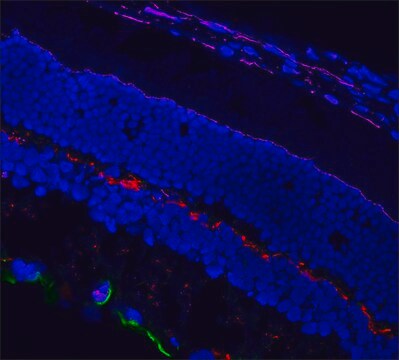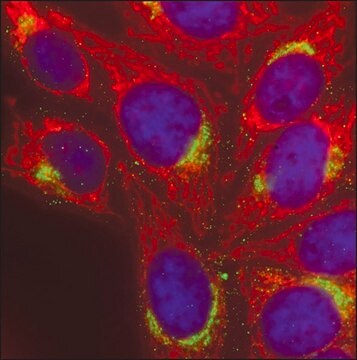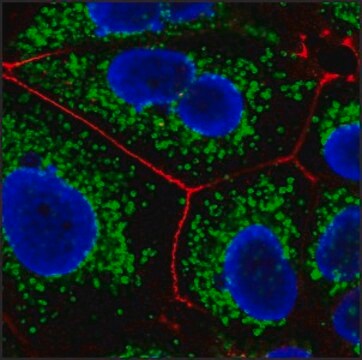General description
This product is prepared by labeling high quality F(ab′)2 fragment of goat anti-rabbit IgG (H+L) with CF568. CF568 is a red fluorescent dye with an excitation spectrum optimally matching the 568 nm line of the Ar-Kr mixed-gas laser. Antibody conjugates of the dye are much brighter than those of Alexa Fluor 568. In addition, the photostability of CF568 is superior to that of Alexa Fluor 568, making CF568 a much better choice for demanding applications, such as confocal microscopy and single molecule imaging.
Specificity
Binds with whole molecule rabbit IgG and the light chains of other rabbit immunoglobulins.
Application
Anti-Rabbit IgG (H+L), F(ab′)2 fragment, CF™568 antibody produced in goat has been used in immunocytochemistry.
Biochem/physiol Actions
Immunoglobulin G (IgG) belongs to the immunoglobulin family and is a widely expressed serum antibody. It consists of a γ heavy chain in the constant (C) region. The monomeric 150kDa structure of IgG constitutes two identical heavy chains and two identical light chains with molecular weight of 50kDa and 25kDa, respectively. The primary structure of this antibody also contains disulfide bonds involved in linking the two heavy chains, linking the heavy and light chains and resides inside the chains. IgG is further subdivided into four classes namely, IgG1, IgG2, IgG3, and IgG4 with different heavy chains, named γ1, γ2, γ3, and γ4, respectively. Limited digestion using papain cleaves the antibody into three fragments, two of which are identical and contain the antigen-binding activity. They are known as fragment antigen binding (Fab) fragments. These fragments contain the light chains paired with the VH and CH1 domains of the heavy chains.
Features and Benefits
Evaluate our antibodies with complete peace of mind. If the antibody does not perform in your application, we will issue a full credit or replacement antibody.
Learn more.Physical form
Supplied in phosphate buffered saline with 0.05% sodium azide, 50% glycerol and 0.2% BSA.
Preparation Note
Protect from light. The antibody solution should be gently mixed before use.
Legal Information
This product is distributed by Sigma-Aldrich Co. under the authorization of Biotium, Inc. This product is covered by one or more US patents and corresponding patent claims outside the US patents or pending applications owned or licensed by Biotium, Inc. including without limitation: 12/334,387; 12/607,915; 12/699,778; 12/850,578; 61/454,484. In consideration of the purchase price paid by the buyer, the buyer is hereby granted a limited, non-exclusive, non-transferable license to use only the purchased amount of the product solely for the buyer′s own internal research in a manner consistent with the accompanying product literature. Except as expressly granted herein, the sale of this product does not grant to or convey upon the buyer any license, expressly, by implication or estoppel, under any patent right or other intellectual property right of Biotium, Inc. Buyer shall not resell or transfer this product to any third party, or use the product for any commercial purposes, including without limitation, any diagnostic, therapeutic or prophylactic uses. This product is for research use only. Any other uses, including diagnostic uses, require a separate license from Biotium, Inc. For information on purchasing a license to use this product for purposes other than research, contact Biotium, Inc., 3159 Corporate Place, Hayward, CA 94545, Tel: (510) 265-1027. Fax: (510) 265-1352. Email: btinfo@biotium.com.
CF is a trademark of Biotium, Inc.
Disclaimer
Unless otherwise stated in our catalog or other company documentation accompanying the product(s), our products are intended for research use only and are not to be used for any other purpose, which includes but is not limited to, unauthorized commercial uses, in vitro diagnostic uses, ex vivo or in vivo therapeutic uses or any type of consumption or application to humans or animals.




